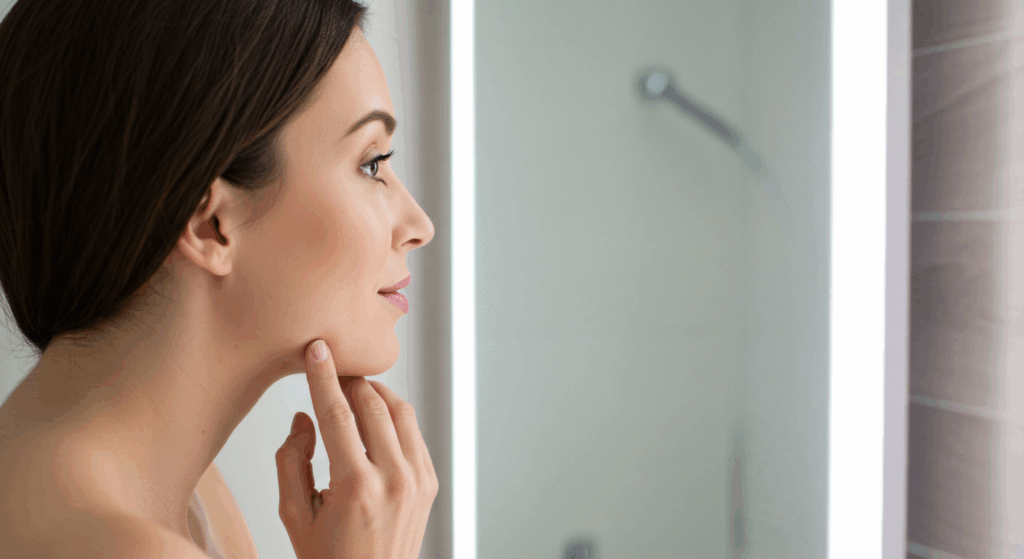For many on the path of gender affirmation, the journey is one of alignment—a process of harmonizing the inner self with the outward reflection. You’ve likely spent countless hours, perhaps even years, researching, reflecting, and dreaming of the moment when the face you see in the mirror truly feels like your own. This journey, while deeply personal, often leads to considering Facial Feminization Surgery (FFS), a powerful set of procedures designed to soften features and affirm a feminine identity.
Within the constellation of FFS procedures, feminization of the mid-face, particularly through cheek augmentation, holds a unique and profound power. It’s about more than just aesthetics; it’s about reshaping the very heart of the face to reflect warmth, softness, and vitality—hallmarks of conventional femininity. The cheeks frame the eyes and balance the entire facial structure, and their contour can fundamentally change how your face is perceived, both by you and by the world.
This comprehensive guide is written for you. It’s for the discerning, well-researched individual who understands that this is not about vanity, but about identity. It’s for “Elara,” our persona for the thoughtful patient who is meticulously planning one of the most significant steps in her life. We will delve deep into the world of cheek augmentation and mid-face feminization within the specific, nuanced context of transgender FFS. We will explore the why, the how, and what you can truly expect on this transformative path to seeing yourself, fully and authentically.

Table of Contents
1. The Core of Identity: Why the Mid-Face Matters So Much in Feminization
Before we discuss surgical techniques, it’s crucial to understand why the cheeks and mid-face are so central to gender perception. This isn’t just about “higher cheekbones”; it’s about shifting the architectural balance of the face to create a profoundly different, and more affirming, impression.
The Anatomic Language of Gender
Socially and biologically, we are conditioned to recognize gender cues in faces instantly. These cues are often subtle and based on the interplay of light and shadow across facial structures.
- Masculine Mid-Face Characteristics: A face that has developed under the influence of testosterone typically presents a flatter, more angular mid-face. The cheekbones (zygomatic arches) are often less prominent and set further back. This creates a more vertically oriented facial structure, with less of the soft, forward projection that creates the “apple” of the cheek.
- Feminine Mid-Face Characteristics: A face developed under the influence of estrogen tends to have more forward projection in the cheek area, creating a fuller, rounder, and softer appearance. This fullness, often referred to as the “ogee curve”—a gentle S-shaped curve from the cheek to the jawline—is a classic signifier of youth and femininity. This curve catches the light beautifully, drawing attention upward towards the eyes.
Alleviating the Pain Point: Gender Dysphoria and Social Invisibility
For a trans woman or transfeminine individual, the flatness of the mid-face can be a significant source of gender dysphoria. It’s a constant, subtle reminder of a masculinized facial framework. This can lead to several of the “pain points” you may be intimately familiar with:
- Misgendering: A flatter mid-face can contribute to being misgendered, as it disrupts the overall harmony of other feminizing features you may have cultivated. Even with perfect hair and makeup, the underlying bone structure can send a conflicting signal.
- Social and Physical Insecurity: The fear of being misgendered or “clocked” can create a pervasive sense of anxiety in social situations, impacting everything from professional confidence to personal relationships. Achieving a “passable” or “stealth” appearance, for many, is a matter of physical and emotional safety.
- The Goal of “Invisibility”: The ultimate aim for many seeking FFS is not to stand out, but to blend in—to be seen simply as a woman, without the preface of “trans.” A feminized mid-face is a cornerstone of achieving this seamless social integration. It helps create a face that is not just seen as “feminine” but is subconsciously and immediately accepted as such.
Cheek augmentation in transgender FFS is, therefore, a corrective and validating procedure. It aims to restore a sense of self by sculpting the facial contours to match your deeply held identity, allowing you to finally feel at peace with your own reflection.

2. The Architect’s Toolkit: Techniques for Mid-Face Feminization
Achieving a natural, elegant feminization of the cheeks is a matter of surgical artistry and technical precision. There is no one-size-fits-all solution. The best approach for you will depend on your unique facial anatomy, your specific goals, the quality of your soft tissue, and your surgeon’s expertise. The two primary methods used in transgender FFS are Cheek Implants and Structural Fat Grafting.
Technique A: Cheek Implants (Malar and Submalar Augmentation)
Cheek implants are a time-tested, reliable method for adding permanent volume and structure to the mid-face. They are made from a biocompatible material, most commonly solid silicone, and are surgically placed directly on the cheekbones.
The Procedure:
The surgery is typically performed under general anesthesia. The surgeon creates a small, hidden incision, usually inside the mouth (intraoral approach) in the gum line above the upper teeth. This approach is favored in FFS as it leaves no visible external scars.
The surgeon then creates a precise pocket on top of the natural cheekbone (zygoma) and carefully inserts the sterilized implant, securing it in place. The incision is then closed with dissolvable sutures. The entire process requires a deep understanding of facial anatomy to ensure the implants are placed symmetrically and in a way that looks natural, not “stuck on.”
Types of Cheek Implants and Their Feminizing Purpose:
It’s not just about adding volume; it’s about adding it in the right place.
- Malar Implants: These are placed directly on the cheekbones. Their purpose is to create the appearance of higher, more prominent cheekbones. This adds angularity and definition in a distinctly feminine way, enhancing the “ogee curve” and lifting the mid-face.
- Submalar Implants: These are placed slightly lower, in the “apple” of the cheek. They are designed to fill out a sunken or flat mid-face, restoring youthful fullness and softness. For many FFS patients, a combination of malar and submalar enhancement is ideal to create that coveted heart-shaped facial appearance.
- Combined Implants: These are custom-designed implants that address both the malar and submalar areas simultaneously, providing a holistic and seamless augmentation.
Pros of Cheek Implants:
- Predictability and Permanence: The results are highly predictable and permanent. The volume and shape added by the implant will not change over time.
- Structural Definition: Implants are excellent for creating significant structural change and a more defined, sculpted look, which can be crucial for counteracting a prominent masculine jawline.
- No Donor Site: Unlike fat grafting, there is no need to harvest tissue from another part of your body.
Cons and Considerations:
- Foreign Body: It is an implant, and while rare, there are risks of infection, shifting, or palpability (being able to feel the edge of the implant).
- The “One Shot” Challenge: The result is entirely dependent on the surgeon’s skill in choosing the right size/shape and placing it perfectly. Adjustments would require another surgery.
- Less Forgiving on Thin Skin: In individuals with very thin facial soft tissue, the edges of an implant might be more perceptible.
Technique B: Structural Fat Grafting (Autologous Fat Transfer)
Structural fat grafting is an increasingly popular and sophisticated technique that uses your own body fat to sculpt and augment the face. It’s a natural, holistic approach that addresses not just volume, but also skin quality.
The Procedure:
This is a two-part process, also performed under general anesthesia.
- Harvesting: The surgeon first performs a gentle form of liposuction to harvest fat from a donor site on your body. Common areas include the abdomen, thighs, or flanks—areas where you might have a little excess fat. This fat is carefully collected in a sterile system.
- Processing and Injection: The harvested fat is then processed—spun in a centrifuge or filtered—to purify it, removing excess oils, water, and blood cells. This leaves only the most viable, healthy fat cells. The surgeon then uses small, specialized cannulas to meticulously inject tiny parcels of this fat into multiple layers of the facial tissue in the cheek area. This micro-droplet technique is crucial for ensuring a smooth contour and maximizing the survival rate of the fat cells.
The Feminizing Power of Fat Grafting:
Fat grafting is not just about “filling.” It’s about sculpting. A skilled FFS surgeon can use it to:
- Create Soft Fullness: Fat provides a uniquely soft, natural-looking volume that mimics youthful facial tissue perfectly. It’s ideal for creating the full, rounded “apple” of the cheek.
- Blend Transitions: It can be used to seamlessly blend the transition from the lower eyelid to the cheek (improving the tear trough area) and from the cheek to the surrounding facial areas.
- Improve Skin Quality: The transferred fat is rich in stem cells, which can have a rejuvenating effect on the overlying skin, improving its texture, thickness, and glow.
Pros of Fat Grafting:
- Completely Natural: It uses your own tissue, eliminating the risks associated with a foreign implant. The results look and feel completely natural.
- Versatile and Customizable: It is highly versatile. The surgeon can place tiny amounts of fat with precision to achieve very subtle and customized contours.
- Dual Benefit: You get the added benefit of body contouring in the area where the fat was harvested.
- Improves Skin: The regenerative qualities of the fat can enhance the overall health and appearance of your facial skin.
Cons and Considerations:
- Unpredictable Absorption: Not all of the transferred fat will survive. On average, surgeons expect about 50-70% of the fat to become permanently integrated. This absorption rate can be unpredictable and varies from person to person.
- May Require Touch-Ups: Because of the unpredictable absorption, a second “touch-up” session may sometimes be needed to achieve the final desired volume.
- Less Structural Definition: For patients needing a significant increase in bony projection, fat grafting alone may not provide the same sharp definition as an implant.
- Requires a Donor Site: You must have enough available body fat to harvest.
Implants vs. Fat Grafting: Which is Right for You?
The choice between implants and fat grafting is a critical one, and it’s a decision you will make in close consultation with your surgeon. Here’s a comparative summary to aid your research:
| Feature | Cheek Implants | Structural Fat Grafting |
| Primary Goal | Structural projection, high definition | Soft volume, contouring, rejuvenation |
| Material | Solid Silicone (Biocompatible) | Your own body fat |
| Permanence | Permanent and stable volume | Partially absorbed; long-term but may reduce |
| Natural Feel | Generally good, but can be palpable | Completely natural; indistinguishable |
| Invasiveness | Surgical pocket creation | Liposuction + injections |
| Scars | None (intraoral approach) | Tiny, near-invisible scars at harvest/injection |
| Key Advantage | High predictability of final shape | Natural results, skin benefits |
| Key Disadvantage | Risk of shifting/infection (rare) | Unpredictable fat survival rate |
| Best For… | Patients needing significant bony projection | Patients needing soft volume and contouring |
In many transgender FFS cases, the most elegant and effective results are achieved through a hybrid approach, where a conservative implant is used to provide the underlying structure, and fat grafting is used to soften the contours and blend the implant for a perfectly natural finish.
3. The Journey: From Consultation to Your New Reflection
Understanding the practical steps of the process is essential for managing expectations and alleviating the natural anxiety that comes with planning a major surgery, especially when traveling abroad for medical tourism.
The Crucial First Step: The Consultation
This is where you move from abstract research to a concrete plan. Your consultation, whether in-person or virtual, is your opportunity to build a rapport with your potential surgeon and ensure they understand your vision.
Be Prepared to Discuss:
- Your “Why”: Don’t just talk about wanting bigger cheeks. Talk about your dysphoria. Explain how your mid-face makes you feel. Show the surgeon photos of yourself where you feel most and least comfortable.
- Your Goals: Bring inspiration photos, but with a caveat. Instead of saying “I want her cheeks,” say “I like the softness and fullness of the cheeks in this photo.” This helps the surgeon understand the qualities you’re after.
- Your Medical History: Be completely transparent about your health, medications, and any hormone therapy you are on.
Key Questions to Ask Your Surgeon:
- “Based on my anatomy, why are you recommending implants/fat grafting/a hybrid approach for me?”
- “Which procedures do you think are most critical for my mid-face feminization?”
- “Can you show me before-and-after photos of patients with a similar facial structure to mine?” (This is more important than seeing their “best” results).
- “What type and size of implant would you choose, and why?” or “How much fat do you anticipate grafting, and what is your expected survival rate?”
- “What are the specific risks I should be aware of with this procedure?”
- “How do you ensure a natural, non-‘overdone’ result?”
Preparing for Your Surgery
Once you’ve chosen your surgeon and booked your date, the preparation phase begins. Your clinic will provide you with a detailed list of instructions, which will likely include:
- Medical Clearances: Standard pre-operative blood tests and health checks.
- Medication Adjustments: You may need to stop certain medications, like blood thinners, and adjust your hormone regimen in consultation with your endocrinologist.
- Logistics (Especially for Medical Tourists): Arranging flights, accommodation, and a companion or support person to be with you during the initial recovery period. Many top FFS clinics in destinations like Istanbul offer packages that assist with these logistics.
- Mental Preparation: This is a huge step. Allow yourself to feel both the excitement and the anxiety. Connect with your support system—friends, family, and online communities in places like Reddit’s
r/transgender_surgeries—to share your feelings.
The Recovery Timeline: What to Realistically Expect
Recovery is a process of patience. The initial healing is relatively quick, but the final results will emerge over many months.
Week 1: The “Hunker Down” Phase
- Immediately Post-Op: You will wake up from anesthesia feeling groggy, with significant swelling and potentially some bruising in the mid-face. If you had an intraoral incision, your mouth will feel tight and sore.
- Pain Management: Pain is generally well-managed with prescribed medication. It’s often described as a deep ache or pressure rather than a sharp pain.
- Swelling and Bruising: This is the peak period for swelling. Your face will look puffy, distorted, and you will not be able to see anything close to the final result. This can be emotionally challenging, so it’s vital to trust the process.
- Activity: Rest is your primary job. You will be advised to sleep with your head elevated to help reduce swelling. Short, gentle walks are encouraged to promote circulation.
- Diet: If you have internal incisions, you will be on a liquid or very soft food diet to protect the sutures.
Weeks 2-4: The Socially Presentable Phase
- Swelling Subsides: A significant amount of the initial, dramatic swelling will have gone down. You will start to look more like yourself again, though still puffy.
- Bruising Fades: Most major bruising will fade, and what remains can often be covered with makeup.
- Returning to Work: Many people feel comfortable returning to a desk job or remote work during this period. Avoid strenuous activity and heavy lifting.
- Sutures Dissolve: Internal sutures will dissolve on their own.
Months 2-6: The Refinement Phase
- Seeing the Shape Emerge: This is when the true magic happens. As the last layers of persistent swelling slowly dissipate, the new contours of your cheeks will become clearly visible.
- Fat Grafting Settling: If you had fat grafting, this is the period where the final “take” of the fat is established. The volume you have at 6 months is likely what will be permanent.
- Numbness: It’s common to have some temporary numbness in the cheek and upper lip area, which will gradually resolve as the nerves heal.
- Emotional Journey: You will start to see “her” in the mirror more and more. This can be an incredibly emotional and validating time.
6 Months to 1 Year+: The Final Result
- Full Maturation: It can take a full year or even longer for every last bit of swelling to resolve and for the soft tissues to fully “settle” into their new positions. The results will continue to soften and look even more natural over time.
- Living in Your New Reflection: The goal is reached. The dysphoria is lessened, the confidence is boosted, and you can move through the world with a sense of peace and authenticity that you have worked so hard to achieve.
4. Mitigating Risks and Ensuring a Safe Journey
Every surgery carries risks, and a trustworthy surgeon will be transparent about them. For cheek augmentation in transgender FFS, these include:
- General Surgical Risks: Infection, bleeding, adverse reaction to anesthesia.
- Implant-Specific Risks:
- Malposition/Shifting: The implant moves from its intended position.
- Asymmetry: The two sides are not perfectly symmetrical.
- Infection: Can sometimes require removal of the implant.
- Nerve Damage: Temporary or (very rarely) permanent numbness in the cheek or upper lip due to stretching of the infraorbital nerve.
- Fat Grafting-Specific Risks:
- Asymmetry: Due to uneven fat survival.
- Over- or Under-Correction: Too much or too little volume remains after absorption.
- Lumps or Irregularities: Can occur if the fat is not injected smoothly.
The single most important factor in minimizing these risks is your choice of surgeon. A board-certified surgeon with extensive, specific experience in transgender FFS is not a luxury; it is a necessity. They will possess the nuanced understanding of facial gender anatomy and the technical skill to execute the procedure safely and effectively, delivering a result that is both beautiful and, most importantly, feels like you.
When vetting surgeons, look for:
- An Extensive Portfolio: Look for consistency and natural-looking results across many different patients.
- Specialization in FFS: A general plastic surgeon is not an FFS specialist. You want someone who performs these procedures as a core part of their practice.
- Patient Testimonials: Look for reviews on platforms like RealSelf and in private FFS communities. Pay attention to how patients describe their experience with the surgeon and their team.

Conclusion: Defining Your Own Elegance
Cheek augmentation and mid-face feminization are more than just a set of surgical procedures. For the trans woman, they are a profound act of self-reclamation. They are about carving out a space in the world where your physical form is no longer a source of conflict but a source of confidence and peace.
The journey requires immense courage, dedication, and meticulous research—all of which you have already demonstrated by seeking out this information. By understanding the anatomy of feminization, the nuances of the surgical techniques, and the realities of the recovery process, you are empowering yourself to make the best possible decisions for your transition.
The goal is to achieve an elegance that is uniquely yours—a natural, soft, and harmonious result that allows your true self to shine through, unburdened by dysphoria. It’s about finally looking in the mirror and being met with the simple, joyful, and life-affirming sight of your own reflection.
Visit Dr.MFO Instagram profile to see real patient transformations! Get a glimpse of the incredible results achieved through facial feminization surgery and other procedures. The profile showcases before-and-after photos that highlight Dr. MFO’s expertise and artistic vision in creating natural-looking, beautiful outcomes.
Ready to take the next step in your journey? Schedule a free consultation with Dr. MFO ( Best Facial Feminization Surgeon for You) today. During the consultation, you can discuss your goals, ask any questions you may have, and learn more about how Dr. MFO can help you achieve your desired look. Don’t hesitate to take advantage of this free opportunity to explore your options and see if Dr. MFO is the right fit for you.








